

Breakdowns On Campus: Students On The Edge. Ryann Liebenthal on Student Loan Forgiveness. Free College, Cancel Debt. Just 30 years ago, tuition and fees at a public, four-year university totaled $3,360 per year in today’s dollars.
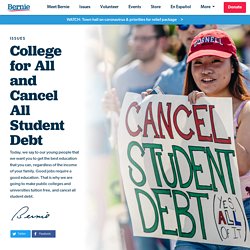
That same degree today costs more than $10,000 per year in tuition and fees and more than $21,000 per year including room and board. Meanwhile, median hourly wages for college graduates have risen by less than $1 since 2001, when adjusted for inflation. The promise of higher pay has not materialized for recent college graduates, who have been taking out more and more in student loans to keep up with the skyrocketing cost of tuition. The Incredible, Rage-Inducing Inside Story of America’s Student Debt Machine. When Leigh McIlvaine first learned that her student loan debt could be forgiven, she was thrilled. In 2008, at age 27, she’d earned a master’s degree in urban and regional planning from the University of Minnesota. DeVos’ Code Words for Creationism Offshoot Raise Concerns About ‘Junk Science’ At a confirmation hearing earlier this month, Betsy DeVos, President Trump’s pick for education secretary, responded to a question about whether she would promote “junk science” by saying she supports science teaching that “allows students to exercise critical thinking.”

This seemingly innocuous statement has raised alarms among science education advocates, and buoyed the hopes of conservative Christian groups that, if confirmed, DeVos may use her bully pulpit atop the U.S. Department of Education to undermine the teaching of evolution in public schools. Creationism in the Classroom: Trump's “Alternative Facts” Despite a lengthy history of being struck down in court, bills permitting the teaching of “creation science” in public schools continue to appear in state legislatures across the country.

In the first month of 2019 alone, five states have introduced creationist bills1. These states are not alone. Should I Major in the Humanities? The unexpected schools fighting to save the liberal arts: military academies and chef schools There also doesn’t seem to be an extraordinary change in what students say they want to get out of a college education.
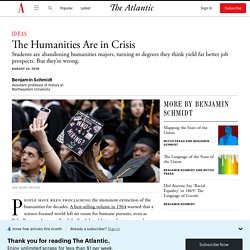
Decades of studies of college freshmen have asked incoming students how important various (and nonexclusive) life goals are to them in the context of their college decisions. The drop in humanities majors in the 1970s, Dennis Ahlburg and Evan Roberts show in a soon-to-be-published book, corresponded to a great inversion. In 1970, seven in 10 students thought it was very important or essential to “develop a meaningful philosophy of life” through education, while about four in 10 (and five in 10 men) put a priority on using it to “make more money.” By the mid-’80s, these ratios had flipped.
A few signs suggest the decline might, eventually, end as quickly as it came on. What comes next will be different. Trump University: Yes, It Was a Massive Scam. Many people believe that higher education is a de facto scam.
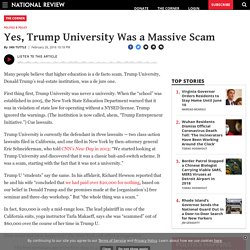
Trump’s bid to end Public Service Loan Forgiveness could mean ‘major life changes’ for some student-loan borrowers. 2020 Presidential Candidates' Higher Education Proposals. As the 2020 presidential election ramps up, NASFAA continues to closely monitor the candidates as higher education policy positions emerge.
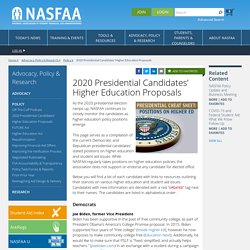
This page serves as a compilation of the current Democratic and Republican presidential candidates' stated positions on higher education and student aid issues. While NASFAA regularly takes positions on higher education policies, the association does not support or endorse any candidate for elected office. Below you will find a list of each candidate with links to resources outlining their stances on various higher education and student aid issues. The Enduring Scandal of Trump University. Federal court approves $25 million Trump University settlement. Trump University: Yes, It Was a Massive Scam. Ivy League 2020 Tuition Comparison and 2021 Estimation. There are 8 colleges and universities in Ivy League.

The Ivy League is a collegiate athletic conference comprising sports teams from eight private institutions of higher education in the Northeastern United States. The conference name is also commonly used to refer to those eight schools as a group. The eight institutions are Brown University, Columbia University, Cornell University, Dartmouth College, Harvard University, Princeton University, the University of Pennsylvania, and Yale University. The term Ivy League also has connotations of academic excellence, selectivity in admissions, and social elitism. General Admission Comparison Between Members in Ivy League All members of Ivy League are private schools.The average acceptance rate of the schools is 7.25% where Harvard University has the tightest acceptance rate of 5.00% and Cornell University has the highest rate of 11%.
Ivy League 2020 Tuition Comparison and 2021 Estimated Costs. The Affirmative Action Battle at Harvard Is Not Over. “Two people could look at the same facts and arrive at different conclusions,” he said.

Standardized Testing: Last Week Tonight with John Oliver (HBO) School Segregation: Last Week Tonight with John Oliver (HBO) Charter Schools: Last Week Tonight with John Oliver (HBO) Everybody Ready for the Big Migration to Online College? Actually, No. Nobody planned for an abrupt mass migration of traditional college courses to the internet.
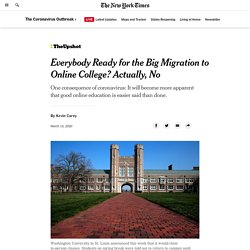
But because of coronavirus, that’s where we are. Hundreds of thousands of students have been told to clear out their belongings and head home, many through the end of the semester. The Coronavirus Exposes Education’s Digital Divide. BEIJING — Like hundreds of millions of other children worldwide, Liu Chenxinhao and Liu Chenxinyuan were getting used to doing class work online.
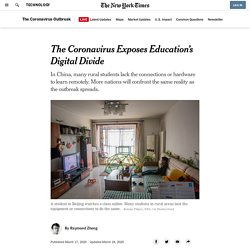
Western Universities Rely on China. After the Virus, That May Not Last. LONDON — On Jiani Zhou’s university campus in southwestern England, the racism arrived before the coronavirus did. One girl headed for the stairs as soon as Ms. Zhou stepped up to a dormitory elevator bank in late January. Is a College Different From a University? The Chronicle of Higher Education, a news outlet, is a stickler for this semantic nuance when referring to individual schools: “A college is obviously not a university, so if a story is about, say, Oberlin, we wouldn’t call it a university,” Heidi Landecker, the publication’s deputy managing editor and copy-desk supervisor, told me in an email.
But when talking about higher education in general, even the Chronicle will fudge the distinction a little. Its house dictionary defines college as “an institution of higher education that grants degrees,” Landecker noted, “so we can and do use ‘college’ to mean ‘university.’” The traditional definitions also have many exceptions. 114,000 Students in N.Y.C. Are Homeless. These Two Let Us Into Their Lives. Ronald Daniels: Colleges must train students for jobs - and also as citizens. Is college worth it? A Georgetown study measures return on investment — with some surprising results. Exactly How Teachers Came to Be So Underpaid in America. Hope Brown can make $60 donating plasma from her blood cells twice in one week, and a little more if she sells some of her clothes at a consignment store. It’s usually just enough to cover an electric bill or a car payment. This financial juggling is now a part of her everyday life—something she never expected almost two decades ago when she earned a master’s degree in secondary education and became a high school history teacher.
Brown often works from 5 a.m. to 4 p.m. at her school in Versailles, Ky., then goes to a second job manning the metal detectors and wrangling rowdy guests at Lexington’s Rupp Arena to supplement her $55,000 annual salary. Arizona Lawmakers Cut Education Budgets. Then Teachers Got Angry.